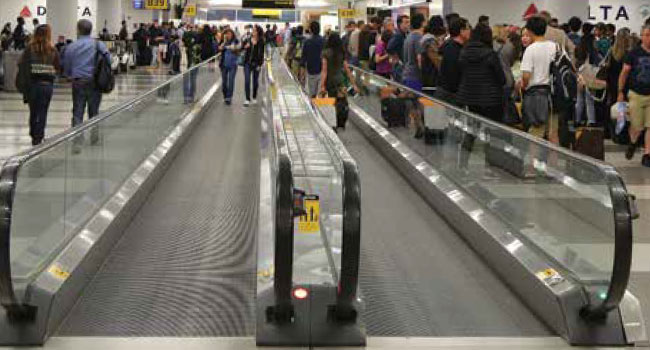
Industry Vertical
Terminal Upgrade
JFK Airport improves functionality and image quality
- By Courtney Pedersen
- Feb 01, 2017
Terminal One at JFK International
Airport had relied
on a limited analog surveillance
system and a separate,
older IP system that were
independent of each other. Both were inadequate
and lacked the functionality that
Terminal One needed. Users could only
view video from specific workstations, it
was difficult to replace or add cameras,
and the system did not integrate easily
with other systems.
Migrating the terminal’s old analog system
to an advanced IP VMS platform was
no small feat. Due to the airport’s high-security
environment, the system and all of its
cameras had to remain operational around
the clock throughout the migration.
To design and implement a new solution,
security integrator Media Wire, LLC,
designed and implemented a Milestone
XProtect Corporate VMS system to manage
500 to 600 cameras, including the installation
of 160 new cameras from Axis
Communications. The Milestone Mobile
client is used by air terminal managers to
view video on their mobile devices. The
VMS can be integrated with Honeywell’s
Pro-Watch access control system so all
alarms and door information can be accessed
from one centralized system. Additionally,
the advanced VMS integrates with
the video from the NVRs used by the terminal’s
restaurants and vendors, enabling
broader coverage of the terminal.
Necessary Upgrades
The VMS provides a significant upgrade
to the terminal’s analog system and greatly
enhanced the ability to monitor and efficiently
respond to incidents. The system’s
search capabilities help operators to
quickly find and identify camera views, for
example by grouped areas such as Gate
10. It provides users with the flexibility to
view any of the nearly 600 cameras from
any workstation throughout the airport, or
from their mobile devices when on-the-go.
Greater video coverage means the terminal
can be protected against a range of
threats, including security breaches, aggressive
actions, or injury and liability issues.
With many agencies requiring access
to the system, from the FBI to building
maintenance, the terminal’s new system is
more user friendly, making it much easier
for operators to manage.
JFK International Airport has been
at the forefront of aviation since its first
commercial flight in 1948. Located 12
miles southeast of Lower Manhattan, the
airport has expanded to include six airline
terminals operated by the Port Authority
of New York. Terminal One opened in
1998 and includes 11 gates and two hardstands
controlled by its own ramp control
tower, which is equipped with state-of-theart
radio communications, weather information
and gate video cameras. It is one
of two terminals at JFK that has the capability
to handle the world’s largest passenger
aircraft, the Airbus A380 aircraft.
Migrating an Aroundthe-
Clock System
The biggest challenge of migrating JFK’s
Terminal One analog system to IP was
keeping all cameras operational throughout
the transition. To do so, technicians took
each live camera and connected it to an additional
working system. In the process, video
from the camera was recorded by both
systems. Once the camera was migrated and
ported to the VMS, the camera was then decommissioned
from the analog system.
Migrating Terminal One’s system required
upgrades to ensure a solid solution
from the ground up. New high-speed fiber
optics, switches, PoE injectors, software,
workstations and operating systems were
installed. The terminal has close to one
Petabyte of storage due to both security
requirements and powerful analytics from
Agent Vi that are used on recorded video,
and to search across cameras. Much
of the management structure is built on
existing Dell servers, but all new servers
are being custom built with close support
from Milestone engineering.
Since the migration involved multiple
VMS clients managing video from cameras
throughout the terminal, technicians
set up a multicasting network to reduce
bandwidth. It allows multiple users to view
the same video stream without taxing the
server, which was lacking with the old analog
system.
An extensive 10 Gig fiber network was
installed to support the bandwidth needed
for current and future cameras. All cameras provide video at the maximum resolutions and frame rates.
Open Platform Meets Tough Demands
The Milestone VMS was selected in large part due to its easy integration with nearly any
third-party system. In Terminal One the VMS had to support older analog systems and
cameras via encoders, also supporting a variety of IP cameras, integrating with access
control and the NVRs used by vendors. The result has been a system that provides JFK
Terminal One with greater access to video and advanced capabilities, including viewing
video on mobile devices.
“The versatility of the system is great and it’s so easy to use,” said the head of security
for Terminal One Management (name omitted for security reasons). “From a
security standpoint, we can capture what we need on a daily basis and it gives us great
visibility into areas we never had before.”
The system is scalable and can accommodate additional or new cameras at any time.
Terminal One’s new Axis cameras easily integrate with the Milestone system and require
less bandwidth that will allow the security team to meet the airport’s lengthy storage
requirements. Axis provides a wide range of cameras for many applications, which even
address the areas where lighting was a concern, like near windows or in stairwells. When
a legacy camera fails or no longer meets the needs of the terminal, it will be replaced
with an Axis IP network camera.
Robust, Easy-to-Use System
Terminal One’s system provides broader coverage and features that make it easier to
automatically monitor possible security concerns, such as an item left unattended. It
also allows the security team to watch for suspicious people, monitor situations and
investigate after the fact.
Users now have shortcuts and keyboard assignments to easily change views or create
camera setback positions. Through integration with the access control system, the
display will also automatically show all alarms and doors being accessed.
This article originally appeared in the February 2017 issue of Security Today.